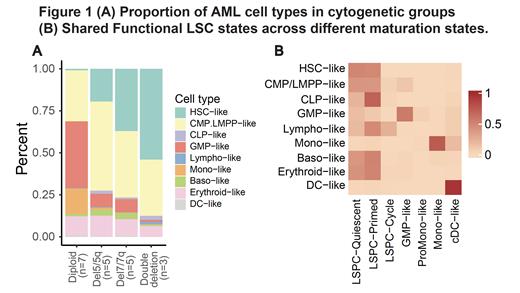Background: Acute myeloid leukemia (AML) is a heterogeneous disease, marked by leukemia stem cells (LSCs), which significantly contribute to treatment resistance and dismal prognosis. While appreciable efforts have been made to study the diversity of functional and phenotypic states of LSCs, integrating these states from inferred single cell profiling has not been explored. Moreover, the spatial distribution and variability of hierarchical leukemic states within diverse cytogenetic groups, and their potential connection to transcriptional profiles, remain understudied, highlighting a gap in our understanding of this complex disease.
Methods: To investigate the heterogeneity across different cytogenetics,we performed single cell RNA profiling (scRNA) of bone marrow (BM) mononulear cells from 20 newly diagnosed adult AML patients with diploid (n=7), del5/5q (n=5), del7/7q (n=5) and double deletion (del5/5q & del7/7q; n=3). A total of 111,130 cells passed quality assessment, of which 56,168 (50.5%) cells were identified as AML cells by integrating flow cytometry, immunohistochemistry, copy number variation, and FISH with the scRNA expression profiles. Functional states of AML cells were predicted by a recently proposed hierarchy of AML LSCs representing distinct maturation states (Zeng et al Nat Med 2022). Phenotypical states were annotated by Symphony using a healthy BM and validated in newly sequenced healthy BM samples. We also applied deconvolution scRNA analysis with spatial GeoMx profiling to identify spatial location of primitive versus differentiated AML cells.
Results: Differential gene expression and gene set enrichment analysis (GSEA) revealed transcriptional and biological diversity across cytogenetic groups. Del7/7q cells showed high expression of human leukocyte antigen (HLA) genes and CD74, consistent with enrichment for a inflammatory phenotype revealed by GSEA. Del5/5q group demonstrated enrichment in proliferative pathways and heat shock proteins. Some diploid cells showed high expression of monocytic markers, while the others were highly expressing GMP markers, indicating the co-existence of different subclones.
Differentiation states of leukemic cells are reflected in the hierarchy of cellular compositions. There is a diverse spectrum of cell types within each cytogenetic group and each patient. However, AML cells from diploid patients were enriched for GMP-like and monocyte-like cells, while phenotypically HSC-like cells showed an incremental trend in the sequence of diploid, del5/5q, del7/7q, and double deletion (Figure 1A). The inferred functional LSC states in our data also showed diverse distribution across cytogenetic groups, with nondiploid cells harboring more LSC. We also evaluated the biological differences of cytogenetic groups within each phenotypical and functional subset. Our data revealed consistent upregulation of proliferation in del5/5q and inflammation in del7/7q with double deletion preserving both features. However, diploid cells were downregulated in almost all. These data suggest cytogenetics as a major driver of ITH even for phenotypically or functionally similar AML cells.
By correlating phenotypical axis with LSC states, we found a shared transcriptional program in LSC-like states across phenotypical axis except for Mono-like and DC-like cells, demonstrating the broad distribution of inferred functional LSC spanning the phenotypical axis from primitive to differentiated cells (Figure 1B). This was also observed in other LSC signatures, suggesting that AML cells with LSC capacity exist across the phenotypic of HSC-like cells to more phenotypically differentiated cells. We then performed spatial deconvolution using GeoMx of CD34 + or CD68 + myeloid areas of interest using the phenotypical signature. GeoMx revealed that primitive cells were more likely to be proximal to bone, while more differentiated states were enriched in distal region from the bone, indicating a spatial migration at time of differentiation.
Conclusions: ScRNA profiling of newly diagnosed AML revealed the existence of heterogeneous LSC functional states underlying varying degrees of differentiation. We identified cytogenetics as a major source of ITH. Also, primitive cells were likely to localize to bone regions. These findings provide new insights in developing specific therapeutic strategies to improve clinical outcomes.
Disclosures
No relevant conflicts of interest to declare.


This feature is available to Subscribers Only
Sign In or Create an Account Close Modal